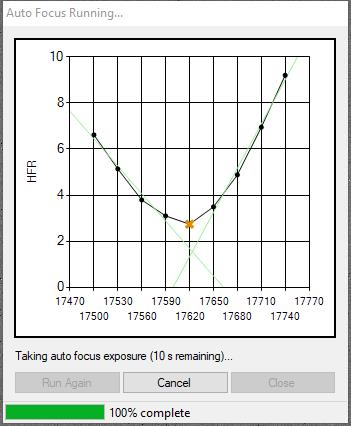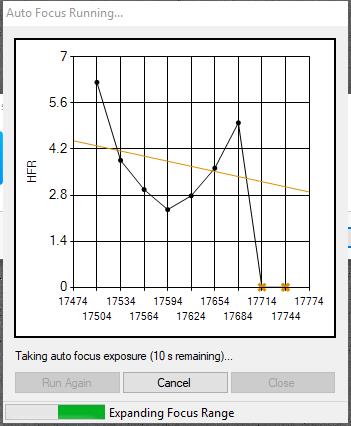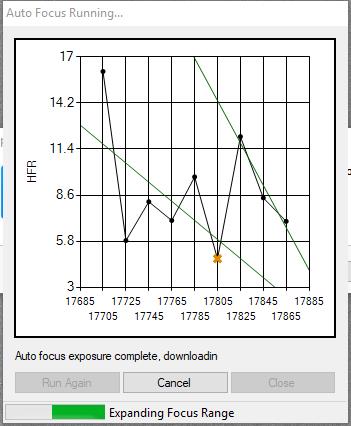Under most circumstances, the auto focus routine does a great job focusing.
There are, however, circumstances when it fails to find focus, and this can easily result in the entire remainder of the night being lost with all images out of focus.
Some, what I think should be easy, fixes can mostly prevent these failures.
The circumstances I frequently run into that can trigger these failures are:
—intermittent clouds
—focusing with narrow band filters
I have a 12" newtonian and a 5" refractor. Both give absolutely perfect V shaped curves with clear weather and LRGB filters. However, with either clouds or NB filters, the following sequence of curves is very common.
This sequence occured last night with clear weather, and a NB filter was being focused.
These were 4 sequential focus runs on my AG12 imaging Newtonian. The first one followed 7 other perfect focus runs. Starting with the next focus run, all focus runs for the remaining 8 hours were badly out of focus. Focus was never restored. Same for the piggy backed SV NP127is 5 inch refractor.




The first image is typical of the first 7 focuses of the night. The following ones were the next 3 focus runs, all images taken on all three badly out of focus. The good focus runs were the first 4 hours, followed by 8 hours of out of focus images.
The option for “Disable smart focus” was CHECKED for both scopes. I have tried both checked and unchecked for this option in an effort to prevent this behavior, and neither one solves the problem.
What is clearly happening in images 2, 3, and 4 is that the focus routine is accepting a value of 0 as a legitimate data point, when it should clearly be ignored. Accepting the 0 data points causes the routine to shift the range out of the valid focus range. Forever after it can never find focus.
Unchecking “Disable smart focus” sometimes allows focus to be reestablished, but not always. It has a particular problem with clouds causing completely random data points, which it happily considers legitimate and comes up with a fairly arbitrary new focus point. Example follows:

I would love to see the focus routine follow the medical motto of “do no harm”. I have lobbied for years for the focus routine to incorporate some simple standard of evaluating the quality of the focus curve, and just doing nothing if the quality is not satisfactory. It could even perform a rerun x times to hopefully achieve a satisfactory run. A simple version of a quality metric could be the sum of the deviations of the data points from the least square fit lines on each side. Ignoring data points of 0 and/or ignoring the entire run if there are some inner 0 data points would be very easy.
If fixes are made to the focus routine, it would also be a good idea to try to solve the focus failures that many folks encounter with long focal length scopes and large central image features. This has not been a problem for me. A possible easy solution to this one is to only consider the smaller stars in any calculation.
Another problem I have noticed with the routine is that it does not use the same set of stars in all the images. The more it does this, the less valid the data points. I think this is only significant if there are very few stars in the image, ie. smaller fields of view, or star poor regions.
Focus files:
